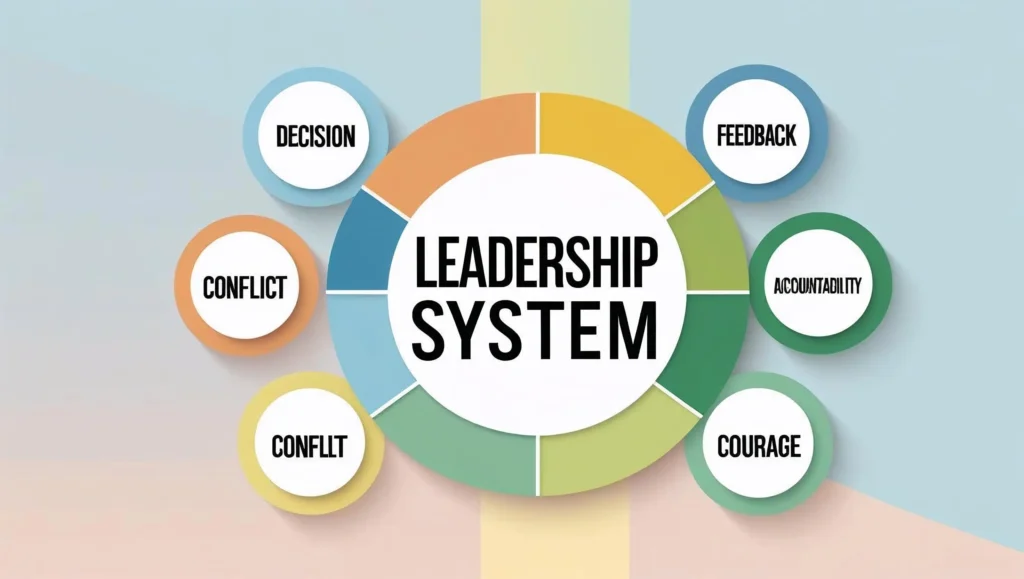
Leadership Is a System — Not Just a Style
Every leader, knowingly or not, builds a leadership system around them — a set of patterns, behaviors, and assumptions that shape how work gets done. Leadership is not just about charisma, communication, or positional authority. It is about what you consistently reinforce, tolerate, and reward — even when you are not present.
We often focus on the “how” of leadership — how to inspire, communicate, or coach — but overlook the more profound, systemic impact of our leadership decisions. Systems are invisible until their effects become impossible to ignore: silos, disengagement, internal competition, fragmentation, or fragile execution.
A striking example comes from the lubricants industry. A divisional head at a global market leader had taken over a region with talented people, but recurring execution failures persisted. While the individuals were skilled and motivated, collaboration between teams was low, and cross-functional blame was rising. To fix this, the leader increased one-on-one check-ins, believing this would create clarity and alignment.
They did not.
What those well-meaning meetings inadvertently reinforced was a culture of isolation. Functions started solving problems vertically, not horizontally. People waited for direction from above rather than working things out together. Critical decisions became fragmented, and the system quietly taught people to prioritize functional wins over collective outcomes.
That is the bizarre truth of leadership: no matter how well-meaning your actions, what you reinforce becomes your system. And eventually, systems become culture.
So pause and ask yourself —What kind of leadership system are you reinforcing right now, and what is it teaching your organization?
What Leadership Systems Are: The Invisible Architecture Behind Behavior
A leadership system is not defined by organization charts or formal performance structures. It lives in the informal, often invisible patterns that influence how people behave, collaborate, and make decisions every day. These systems take shape not through what leaders say, but through what they consistently do—what they model, what they tolerate, and what they choose to reward.
At their core, leadership systems include the following:
Decision-making dynamics
Who gets consulted, who gets informed, and who gets ignored?
In many teams, decisions are quietly made in small circles, and others only learn about them after the fact. Over time, this teaches people that their input is not needed, and eventually, it is not worth offering. It creates a divide between “core” and “peripheral” players, breeding disengagement, territorial behavior, or silent resentment.
Communication patterns
Are discussions inclusive or hierarchical? Is silence interpreted as agreement?
In some meetings, only the loudest voices speak, while others default to silence, not out of agreement, but because they feel unheard. If questions are seen as challenges rather than contributions, you unknowingly create a culture where people nod in public and disagree in private.
Conflict resolution
Is disagreement safe and encouraged, or avoided and punished?
When leaders shut down tension too quickly to “keep the peace,” real issues go underground. People stop raising concerns. Eventually, surface harmony masks deep dysfunction. On the other hand, when respectful disagreement is modeled and normalized, teams become sharper, more resilient, and better aligned.
Recognition and reinforcement
What behaviors are praised or promoted? What goes unnoticed?
If only outcomes are celebrated — not the collaboration, courage, or initiative behind them — people learn to chase visibility rather than value. Over time, shortcuts get rewarded, and quiet contributors feel invisible. Recognition is not just morale-boosting; it is system-setting.
Alignment mechanisms
Are goals shared across functions or fragmented by department?
When every team chases its metrics in isolation, turf wars emerge. Progress in one area creates roadblocks in another. But when leadership consistently reinforces shared goals and celebrates cross-functional wins, a system of mutual accountability and enterprise thinking takes root.
Unlike formal processes, these systems operate in the background. They are felt more than seen, but their impact is measurable in engagement scores, execution speed, trust levels, and retention. They shape what people believe is “how things work here.”
For example, if leaders consistently bypass cross-functional input in favor of speed, a system of functional silos will form. If leaders tolerate poor behavior from high performers, a system of performance over values takes root. Over time, these systems condition employee behavior more than any handbook ever could.
This is why culture is not built by intention alone — it is built by repetition. And leaders are the ones who set that rhythm, whether they realize it or not.
What Systems Are You Reinforcing? Unintended Messages Leadership Sends Daily
Most leadership systems are not consciously designed — they emerge. Leaders often reinforce specific dynamics not by intention but by default.
For instance, when a leader:
- Responds to every issue themselves — it reinforces a system where escalation replaces ownership.
- Avoids visible conflict to maintain a “cordial” atmosphere — it creates a system where silence is rewarded, and feedback is suppressed.
- Publicly praises only outcomes, not the behavior that led to them — it builds a system of short-term wins over long-term capability.
- Holds strategic conversations only with a few trusted team members — it silently codifies a system of information inequality and closed influence loops.
These actions, repeated enough, become the “rules” of the workplace, regardless of what is written in the vision statement or values deck. And they send powerful signals about what is truly valued, what will get you ahead, and what should be avoided.
A telling question for any leader is:
“If someone were promoted by perfectly mirroring how your team works today, would you be proud of what they learned?”
Often, the behaviors that get unintentionally reinforced are the very ones that undermine long-term performance, trust, and culture. They breed invisible friction — from passive-aggressive communication and silo protectionism to decision fatigue and quiet quitting.
The key insight here is this:
Your team does not learn from your intentions — they learn from your patterns, your habits, and daily behavior. And patterns become systems.
The Culture You Build Is the System You Allow
Culture is not what is written on office walls. It is what happens in the hallways, in Zoom calls, in team huddles, and moments of tension. It is not a slogan. It is a pattern, and patterns, when repeated, become systems.
Leaders often assume grand initiatives drive culture. In reality, it is shaped by small daily reinforcements:
- What gets tolerated
- What gets rewarded
- Who gets listened to
- What gets ignored
- Where the energy flows
If you consistently overlook passive-aggressive behavior to avoid conflict, you create a culture where honesty is unsafe.
If performance reviews praise only results but overlook behavior, you teach people to prioritize winning at all costs.
If you allow cross-functional decisions to happen in silos, you reward protectionism over transparency.
In short, the culture you build is the system you allow — and it either builds trust and engagement from the inside out or fractures it silently over time.
Case in Point: Satya Nadella at Microsoft
When Satya Nadella assumed his charge as CEO of Microsoft in 2014, the organization was high-performing but internally rigid. The culture had calcified around competition — teams operated in silos, collaboration was weak, and employees often felt afraid to admit mistakes. Innovation was slowing, and morale was low.
Nadella did not start with a strategy overhaul. He began with a cultural reset.
Satya introduced a shift from a “know-it-all” to a “learn-it-all” mindset. This was not just a tagline — behavioral expectations backed it:
- Leaders began publicly sharing what they were learning
- Employees were encouraged to ask questions, stay curious, and experiment without fear of failure
- Performance reviews started to value collaboration and learning over solo brilliance
Over time, Microsoft has transformed into a learning organization — one that is more agile, humane, and innovative. Today, it is one of the most admired companies in the world, not just for its products but also for its cultural transformation.
The lesson is clear: Culture is not what leaders say only; it’s what they systematize.
If you:
- Reward intellectual humility → People will be honest.
- Encourage learning → People will experiment.
- Act on feedback → People will speak up.
- Protect status over purpose → You will build a culture of silence.
Every system, even if unintentional, becomes the silent architect of your culture. As I explored in a previous article, culture — not just strategy — determines the long-term trajectory of an organization.
Self-Audit: What Are You Reinforcing Without Realizing It?
Leadership systems often run silently in the background, shaping behaviors, decisions, and dynamics without ever being explicitly designed. That is why it is not enough to ask, “What am I doing as a leader?”
A more powerful question is: “What is my leadership creating — even when I am not in the room?”
If you want to understand the system you might be reinforcing without realizing it, pause and take an honest look at what is actually happening around you. The patterns you notice will likely tell you more than any formal strategy document or polished set of values ever could.
Leadership System Self-Audit:
I. Do my systems invite truth, or protect comfort?
Are people encouraged to speak honestly, even when the truth is uncomfortable? Or do they default to silence, guessing what I want to hear?
ii. Do people wait for me, or move with clarity?
Does the team have shared goals, clear priorities, and the confidence to act? Or does every decision funnel back to me, creating dependence?
iii. What behaviors get invisible rewards here?
Do we celebrate collaboration, ownership, and learning from failure, or are subtle signals promoting turf wars, heroics, or staying quiet?
iv. What happens when mistakes occur?
Is failure treated as a chance to learn, or a reason to blame and retreat?
v. Is influence distributed or hoarded?
Do decisions and recognition flow across the team, or remain in a few hands?
These are not questions for perfection — they are questions for awareness. Whatever behavior you consistently allow, ignore, or reward is being reinforced as “how we do things here.”
And that, ultimately, becomes your culture.
Build Better Systems: From Reaction to Intentional Design
No system is set in stone. And no culture is too far gone to change.
The most effective leaders are not the ones who control everything — they are the ones who design environments where good things happen by default.
Leadership maturity is evident when you stop reacting to cultural symptoms and start redesigning the system beneath.
Here is how:
I. Start with clarity, not control
Set clear priorities, roles, and behavioral expectations. Clarity reduces the need for micromanagement. It creates a shared map, so people can act without always needing to ask.
ii. Co-create systems with your team
Invite the people closest to the work to shape how it flows. Involve them in defining rituals, feedback loops, and meeting norms. When people build the system, they take ownership of the outcome.
iii. Introduce intentional forums, such as “Capability Meetings” or “Cultural Health Checks”
Replace information-hoarding 1:1s with small-group capability meetings that mirror how real work happens — across functions.
Use quarterly cultural reviews to ask: What behaviors are we rewarding? What patterns are emerging? What needs a redesign?
These are not cosmetic changes — they are design-level decisions that shape how your organization breathes, communicates, and grows.
Optional Inspiration
As emphasized in Harvard Business Review’s 2025 article, senior leaders must re-engineer how their time and decisions scale across systems, replacing isolated meetings with cross-functional conversations that reflect real collaboration and capability-building.
Systems leadership is not just about process. It’s about engineering alignment, trust, and adaptability — by design, not by accident.
Conclusion: You Are a System Builder — Whether You Know It or Not
Every leader — by action or inaction — becomes a system builder.
You do not need a formal title in systems design. You already have one.
Every decision you make, every behavior you tolerate, every conversation you avoid — all of it reinforces something.
And over time, those small reinforcements compound into the operating culture people experience every day.
So ask yourself: “What system did I reinforce today — and is it one I am proud of?”
Leadership is not just about what you say or even what you believe — It is about what you make possible, what you normalize, and what you let slide.
The best leaders are not just culture creators and nourishers; they are architects of alignment, shaping systems where people thrive, collaboration flows, and clarity replaces chaos.
If this perspective on leadership systems resonates with you, explore Sarwar’s Leadership Journey — Learn more about my work, insights, and experiences.
Connect for Conversations or Collaborations — If your organization is exploring leadership system redesign, I welcome thoughtful dialogue.
Disclaimer: This article is based on personal experience and insights. It does not constitute financial, legal, or medical advice.





